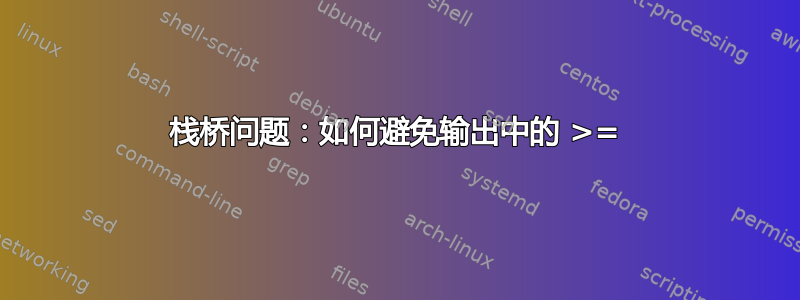
TeX 字符之间不留空格\mathrel,因此可以输入 := 来定义。但粗心的作者经常会输入类似
< a, b > = < c, d >
表示两个标量积相等,并使中间三个字符粘在一起,等号周围没有空格。(我确实告诉他们使用\langleand \rangle,这很有用。)至少\mathrel在这种情况下,有没有巧妙的方法可以覆盖惯例,以便等号与其他符号分开,但仍然是数学关系字符?
答案1
诀窍是将文档中出现的所有<和的列表存储在 aux 文件内,并在第二次运行中使用它来决定什么应该是和,什么应该是和。><>\left\langle\right\rangle
解决方案有点长,抱歉。请参阅内联评论。
\makeatletter
% We could probably add some customization here.
%
% < and > as a relation or as a delimiter
\mathchardef\lt@relation=\mathcode`\<
\mathchardef\ltgt@bar@relation=\mathcode`\|
\mathchardef\gt@relation=\mathcode`\>
% Note: \ltgtstep and \ltgtunstep are needed because of the
% \left and \right. Also note that their placement (inside the group)
% is critical.
\def\lt@delimiter{\left\langle\ltgtstep}
\def\ltgt@bar@delimiter{\middle|}
\def\gt@delimiter{\ltgtunstep\right\rangle}
% < and > revert to the relation symbol if the .aux
% disagrees with what we see in the current run.
\let\lt@error@relation\lt@relation
\let\ltgt@bar@error@relation\ltgt@bar@relation
\let\gt@error@relation\gt@relation
\let\lt@error@delimiter\lt@relation
\let\ltgt@bar@error@delimiter\ltgt@bar@relation
\let\gt@error@delimiter\gt@relation
% As in other solutions, we make < and > active in math mode.
% The corresponding control sequences have been defined above.
\begingroup
\catcode`\<=\active
\catcode`\|=\active
\catcode`\>=\active
\gdef<{\lt@active}
\gdef|{\ltgt@bar@active}
\gdef>{\gt@active}
\endgroup
\mathcode`\<="8000
\mathcode`\|="8000
\mathcode`\>="8000
% ===================
% The above commands will be called via
% \csname lt@\ltgt@error@\ltgt@type\endcsname
% where \ltgt@error@ is {} by default and can be {error@}, and
% where \ltgt@type is {relation} or {delimiter}.
\gdef\ltgt@error@{}
\def\ltgt@type{relation}
% \ltgt@list will hold our list of "<", ">", "|". Each time we append,
% we check that the symbol agrees with the corresponding one from the
% .aux file. If not, we fall back on the error mode.
\gdef\ltgt@list{}
\def\ltgt@append#1{%
\xdef\ltgt@list{\ltgt@list#1}%
\ltgt@prev@pop%
\unless\ifx\ltgt@prev@head#1%
\gdef\ltgt@error@{error@}%
\fi%
}
% We pop the list from the .aux file as we construct the new list.
\def\ltgt@prev@pop{\expandafter\ltgt@prev@pop@aux\ltgtprevlist\relax\relax}
\def\ltgt@prev@pop@aux#1#2\relax{%
\xdef\ltgtprevlist{#2}%
\ifx#1\relax%
\global\let\ltgt@prev@head\relax%
\else%
\global\let\ltgt@prev@head#1%
\fi}
% To take care of grouping
\def\ltgt@append@open{%
\loop
\ifnum\ltgt@depth<\currentgrouplevel
\ltgt@append{(}%
\global\advance \ltgt@depth by 1\relax
\def\ltgt@type{relation}%
\repeat
}
\def\ltgt@append@close{%
\loop
\ifnum\ltgt@depth>\currentgrouplevel
\ltgt@append{)}%
\global\advance \ltgt@depth by -1\relax
\aftergroup\ltgt@append@close
\repeat}
% We will later \let<\lt@active and \let>\gt@active. For now, we just
% define these commands. Each has two pieces: first fill the \ltgt@list,
% putting many "|" to ensure that different groups are really separated
% by at least one "|". Second, typeset the correct symbol depending on
% what can be read from the prevlist (extracted from the .aux file).
\newcount\ltgt@depth
\def\ltgtstep{\global\advance\ltgt@depth by 1\relax}
\def\ltgtunstep{\global\advance\ltgt@depth by -1\relax}
\def\ltgt@openclose{%
\aftergroup\ltgt@append@close%
\unless\ifnum\ltgt@depth=\currentgrouplevel%
%\global\ltgt@depth\currentgrouplevel%
\ltgt@append@open%
\fi%
}
\def\lt@active{%
% fill the list
\ltgt@openclose%
\ltgt@append{<}%
% typeset
\ltgt@ifnextgt@TF{\def\ltgt@type{delimiter}}{\def\ltgt@type{relation}}%
\csname lt@\ltgt@error@\ltgt@type\endcsname%
}
\def\ltgt@bar@active{%
% fill the list
\ltgt@openclose%
\ltgt@append{|}%
% typeset
\csname ltgt@bar@\ltgt@error@\ltgt@type\endcsname%
}
\def\gt@active{%
% fill the list
\ltgt@openclose%
\ltgt@append{>}%
% typeset
\csname gt@\ltgt@error@\ltgt@type\endcsname%
\def\ltgt@type{relation}%
}
% When we see a <, we use \ltgt@ifnextgt@TF{.t.}{.f.} to test if the
% head of the prevlist is a >. If so, we execute {.t.}, otherwise {.f.}.
\newcount\ltgt@ifnextgt@count
\def\ltgt@ifnextgt@TF{%
\global\ltgt@ifnextgt@count0\relax%
\expandafter\ltgt@ifnextgt@readone\ltgtprevlist\relax\relax%
\expandafter\ltgt@ifnextgt@aux\ltgtprevlist\relax%
}
\def\ltgt@ifnextgt@readone#1{%
%\ltgt@ifnextgt@count
%\@ltgt@ifnextgt@false%
\ifx#1\relax
\expandafter\ltgt@ifnextgt@throw@FT
\fi
\ifx#1(%
\global\advance\ltgt@ifnextgt@count by 1\relax
\fi
\ifx#1)%
\global\advance\ltgt@ifnextgt@count by -1\relax
\fi
\ifnum\ltgt@ifnextgt@count<0\relax % no ">" can be found.
\expandafter\ltgt@ifnextgt@throw@FT
\fi
\ifnum\ltgt@ifnextgt@count=0\relax
\ifx#1<\relax % the first relevant character is not ">"
\expandafter\expandafter\expandafter\ltgt@ifnextgt@throw@FT
\else
\ifx#1>\relax % ">" was found!
\expandafter\expandafter\expandafter\expandafter
\expandafter\expandafter\expandafter\ltgt@ifnextgt@throw@TF
\fi
\fi
\fi
\ltgt@ifnextgt@readone
}
\def\ltgt@ifnextgt@throw@FT#1#{\ltgt@use@FT}
\def\ltgt@ifnextgt@throw@TF#1#{\ltgt@use@TF}
\def\ltgt@ifnextgt@aux#1#2#{% arg #2 delimited by brace, thrown away.
\ifx#1>%
\expandafter\ltgt@use@FTF%
\else%
\ifx#1|%
\expandafter\expandafter\expandafter\ltgt@use@T%
\else%
% \ifx#1(%)
% \expandafter\expandafter\expandafter\expandafter
% \expandafter\expandafter\expandafter\
\expandafter\expandafter\expandafter\ltgt@use@FFT%
\fi%
\fi%
{\ltgt@ifnextgt@aux#2}%
}
\long\def\ltgt@use@T#1{#1}
\long\def\ltgt@use@TF#1#2{#1}
\long\def\ltgt@use@FT#1#2{#2}
\long\def\ltgt@use@FTF#1#2#3{#2}
\long\def\ltgt@use@FFT#1#2#3{#3}
% We put the definition of the relevant list in the .aux file at the end
% of the run. This file is read at \begin{document}.
\AtEndDocument{\write\@auxout{\gdef\noexpand\ltgtprevlist{\ltgt@list}}}
%
% To ensure that \ltgtprevlist is defined in the first run, we do
\let\ltgtprevlist\relax
% Embedding the test example in the package itself (bad idea, but eh...)
\unless\ifx\documentclass\@twoclasseserror
\documentclass{article}
\begin{document}
The middle delimiter now works: $<a^2|x_{\sum_{i>j_1}i}>$, and nesting as well:
\[
<\frac{<u|v>+<v_1|v_2>}{<v_1|v>} v_1|v > = <u|v> + <v_1|v_2>,
\qquad {i<j}, {k>l}. % Note the use of braces to prevent seeing <j,k>.
\]
How come the end didn't become $i<j, k>l$? because I enclosed each
inequality in braces. Another case where this can be useful is to get
$<{<a,b>} a,b> = <a,b>^2$.
One more test:
\[
< {\sum |\lambda_i| v_i}| v > = 0
\]
\end{document}
\fi
答案2
有些作者确实想将<...>运算符与区分开来\langle...\rangle。在这种情况下,您可以通过以下方式获得正确的间距:
\newcommand*\diam [1] {\mathopen< #1 \mathclose>}
\newcommand*\scal [1] {\langle #1 \rangle}
% usage: \( \diam{\phi} = \diam{\psi} \neq \scal{\phi, \psi} \)
我很惊讶之前没人提到过这一点。
答案3
如果你可以让他们使用任何宏来实现这一点,那么
\newcommand*\sp[2]{\langle#1,#2\rangle}
可能是可行的方法。(好吧,也许不是,\sp因为那是\let,^但可以指示标量积。)
由于您可能不希望在最终输出中出现小于或大于的情况,并且您的合著者不太可能会更改,因此您可能只需进行最后检查并修复他们的小错误。这就是我所做的。
答案4
更好的是,Lev Bishop 的回答在相关问题上,使用数学工具你可以定义:
\DeclarePairedDelimiter\ip{\langle}{\rangle}
然后将其\ip{a,b}用于内部产品。最棒的是,您还可以免费获得带星号的版本\ip*{a,b},它将根据需要自动调整分隔符的大小。


